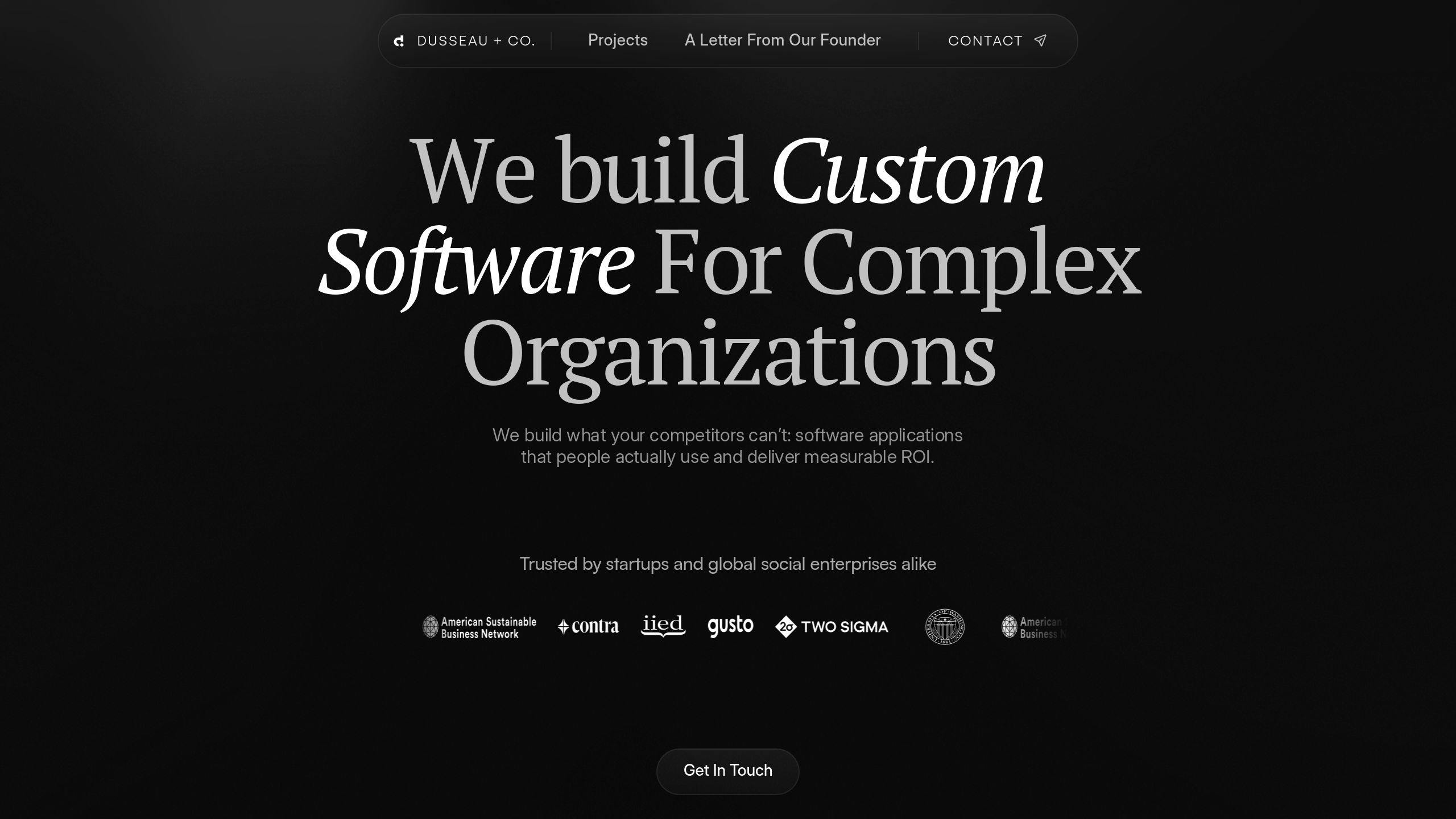Digital Transformation Checklist for Financial Services
Jan 16, 2025

digital-transformation-checklist-for-financial-services
Digital Transformation Checklist for Financial Services
Digital transformation is no longer optional for financial services. It’s a must to stay competitive, meet customer demands, and comply with regulations. The industry is projected to reach a $145.6 billion market size by 2025, growing at 22.1% annually. But 70% of initiatives fail due to poor planning. Here's a quick guide to get it right:
Start with an Assessment: Identify gaps in legacy systems, workflows, and customer experience.
Define Clear Goals: Focus on customer satisfaction, operational efficiency, compliance, and innovation.
Adopt Key Strategies: Prioritize AI for personalization, cloud for agility, and automation for efficiency.
Ensure Security: Implement zero-trust architecture and advanced compliance tools.
Use the Right Tools: AI, cloud platforms, and ERP systems can cut costs, reduce errors, and improve speed.
Implement in Phases: Test, scale, and monitor progress with a cross-functional team.
Bottom line: Audit your current systems, set measurable goals, and choose tools that align with your needs. Success depends on preparation, teamwork, and continuous improvement.
6 Steps Financial Services Should Take for Digital Transformation
Pre-Transformation Assessment: Preparing for Change
Before diving into a digital transformation, it's crucial to evaluate where you currently stand. McKinsey research highlights a stark reality: 70% of digital transformation projects fail due to poor preparation and unclear objectives [1].
Evaluating Existing Systems and Processes
Start by examining these critical areas:
For example, in 2022, Bank of America tackled customer service delays by introducing AI tools. This move slashed wait times by 30% and increased customer satisfaction by 25% [2].
Defining Clear Transformation Goals
Use your assessment findings to set specific, actionable goals that align with your business needs. These goals should cover both regulatory requirements and broader business ambitions.
Key focus areas include:
Customer Experience Metrics: Pinpoint targets for satisfaction, faster response times, and increased digital engagement.
Operational Efficiency: Identify automation opportunities and set cost-saving benchmarks.
Compliance and Security: Define clear standards for adhering to regulations and minimizing risks.
Innovation Objectives: Outline measurable goals for rolling out new digital services.
Building Stakeholder Support
Getting stakeholders on board is critical to moving forward with your transformation plans.
Here’s how to win their support:
Present a Strong Business Case: Clearly outline the risks of inaction and the benefits of transformation.
Involve a Cross-Functional Team: Bring together experts from IT, operations, compliance, and customer service to ensure diverse perspectives.
Demonstrate ROI: Show the balance between short-term costs and long-term advantages to secure necessary resources.
Once stakeholders are aligned, you’ll be ready to select the strategies and tools that will drive your transformation forward.
Key Strategies for Transformation
Using insights from our assessment findings, let’s dive into the main strategies that drive digital transformation in financial services. According to Deloitte's 2022 report, 71% of financial institutions have already started digital transformation efforts, with customer experience as their top priority [3].
Improving Customer Experience
Today, customers expect smooth digital interactions at every touchpoint. For example, JPMorgan Chase revamped its mobile app with AI-driven personalization, resulting in a 42% jump in customer engagement and a 28% drop in support tickets [4].
Here are some practical approaches:
While enhancing customer experience is crucial, improving operational efficiency is just as important for sustainable growth.
Increasing Efficiency
Addressing inefficiencies like manual processes and slow workflows is key. For instance, Capital One’s 2022 shift to AWS cloud reduced operational costs by 20% and tripled the speed of service deployment [5].
Key areas of focus include:
Process Automation: Use RPA for routine tasks like account reconciliation or compliance checks.
Cloud Infrastructure: Implement scalable cloud solutions to boost agility and reduce costs.
Real-time Analytics: Analyze data instantly for quicker, better-informed decisions.
However, boosting efficiency must go hand-in-hand with maintaining strong security and compliance measures.
Ensuring Security and Compliance
A robust security strategy is non-negotiable in financial services. Three key components stand out:
Zero-Trust Architecture: Goldman Sachs cut security incidents by 40% in 2023.
AI for Compliance: Morgan Stanley reduced audit preparation time by 60% in 2024.
Data Privacy Enhancements: Mastercard achieved zero breaches in 2023 by using blockchain.
"Successful digital transformation requires a secure, efficient ecosystem that balances innovation, customer experience, and compliance", says Deloitte’s Financial Services Director in their 2022 report [7].
Tools and Technologies for Transformation
Once strategies are set, the next step is choosing the right tools and technologies to bring those plans to life. According to Gartner's 2021 report, 75% of financial services organizations now use integrated technology solutions to support their digital transformation efforts [1].
Using Cloud Platforms for Growth
Cloud platforms play a major role in helping financial institutions improve their operations. A great example is Capital One's move to the cloud, which delivered measurable benefits:
Leveraging AI and Automation
AI is reshaping how financial institutions handle operations and customer interactions. Take Deutsche Bank, for instance: by 2024, their AI-powered risk assessment tools cut false positives by 35% and boosted fraud detection accuracy by 45% [3]. Here are some other key improvements:
ERP Systems: Dusseau and Company

Dusseau and Company's ERP solutions offer financial institutions tools for automation, real-time analytics, and compliance monitoring. AXA's adoption of these systems led to a 95% improvement in financial reporting accuracy and an 80% reduction in compliance risks, thanks to automated monitoring and reporting [4].
"The key to successful digital transformation lies in selecting technology solutions that align with specific business needs while ensuring scalability and security", says Mark Dusseau, underlining the importance of tailored implementation [9].
Implementation and Monitoring: Ensuring Success
Once your strategies and tools are ready, the key to success lies in breaking down the process into manageable phases, keeping a close eye on progress, and fostering teamwork.
Implementing in Phases
Rolling out changes in stages helps minimize risks and makes the process more manageable. Here's what each phase typically involves:
Monitoring and Adjusting
Keeping tabs on progress in real-time with advanced analytics tools is a game-changer. These tools not only boost efficiency but also cut down security issues by 60% and encourage AI adoption by 88%. Consider these stats from organizations using modern analytics:
Forming a Transformation Team
A strong transformation team is essential for success and typically includes:
Project Management Office: Oversees timelines and deliverables.
Technical Specialists: Handle the nitty-gritty of system implementation.
Change Management Experts: Ensure smooth transitions and team buy-in.
Cross-functional collaboration is critical to aligning technology with business goals and staying compliant with regulations.
"The key to successful digital transformation lies in building a team that combines technical expertise with deep understanding of financial services operations. This ensures that technological changes align with business objectives while maintaining regulatory compliance", says a senior executive from Temenos Banking Cloud [2].
Mambu's recent projects highlight this approach. Their cloud-native banking platform helped financial institutions cut product launch times from months to weeks, thanks to well-structured, cross-functional teamwork [2].
To stay on track, organizations should focus on:
Regular reviews and open communication to adapt as needed
Maintaining compliance with regulatory standards throughout the process
With the right team and tools, navigating digital transformation becomes much more manageable and effective.
Conclusion: Next Steps
Key Points Recap
Transforming financial services through digital innovation requires blending modern technologies, improving workflows, and encouraging teamwork across teams. Recent stats highlight the potential: 88% growth in AI adoption and 25,000 hours saved yearly through automation.
Three main areas form the backbone of this transformation:
These pillars provide a roadmap for organizations ready to embrace change.
Actionable Steps
To get started, focus on these two priorities:
Audit Current Systems for Gaps: Review your existing tech setup to pinpoint areas needing improvement.
Define Goals and Choose Solutions: Set measurable goals that align with your strategy and pick the right tools to achieve them.
"Digital transformation isn't just about technology - it's about reimagining how we serve our customers and operate our business. The key is to start small, measure results, and scale what works", explains a senior executive from Temenos Banking Cloud [2].
Start by tackling areas where digital tools can deliver fast results while keeping an eye on long-term goals. Partnering with experts like Dusseau and Company can help speed up progress with ERP solutions and industry know-how.